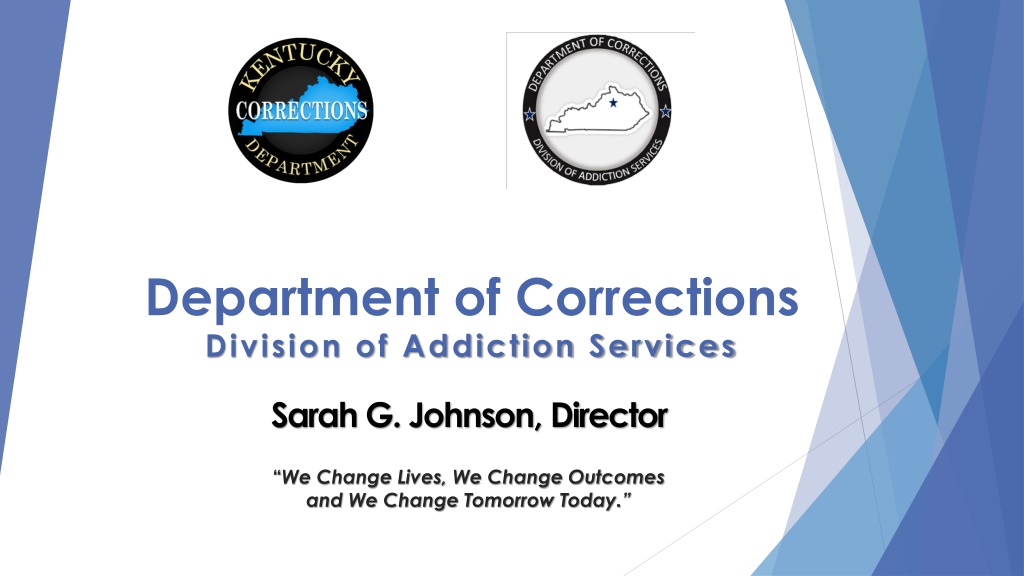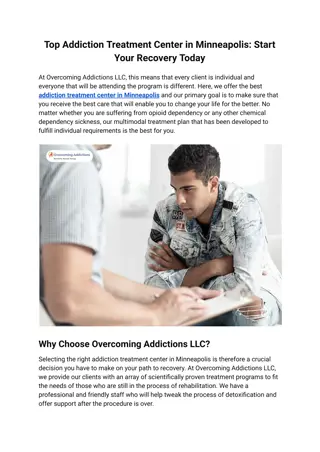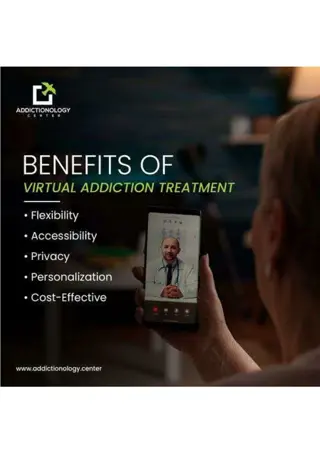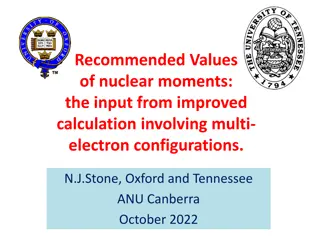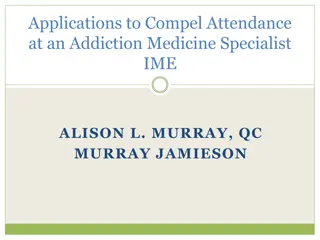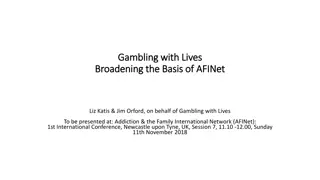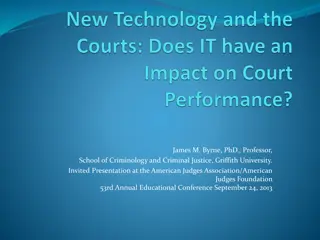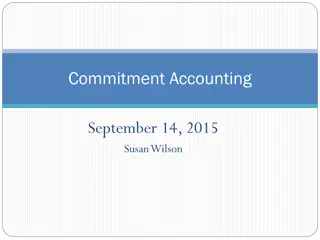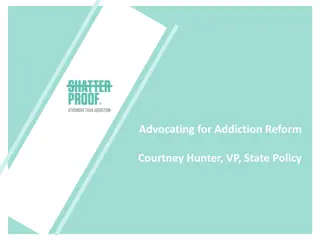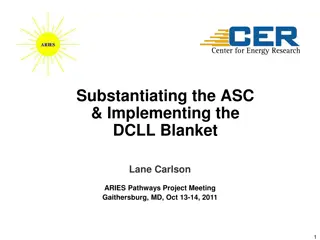Department of Corrections Division of Addiction Services Organizational Structure
Sarah G. Johnson serves as the Director of the Department of Corrections Division of Addiction Services, leading a team that aims to change lives, outcomes, and the future. The organizational chart includes roles such as Deputy Commissioner, Community Programs Director, Branch Managers, and Administrative Specialists across various regions. The Division is dedicated to providing addiction services and support across different regions through a structured and organized approach.
- Department of Corrections
- Addiction Services
- Organizational Structure
- Sarah G. Johnson
- Division Regions
Download Presentation

Please find below an Image/Link to download the presentation.
The content on the website is provided AS IS for your information and personal use only. It may not be sold, licensed, or shared on other websites without obtaining consent from the author. Download presentation by click this link. If you encounter any issues during the download, it is possible that the publisher has removed the file from their server.
E N D
Presentation Transcript
Department of Corrections Division of Addiction Services Sarah G. Johnson, Director We Change Lives, We Change Outcomes and We Change Tomorrow Today.
Division of Addiction Services Organizational Chart DOC Commissioner Deputy Commissioner Community Programs Director of Addiction Services Assistant Director of Addiction Services Executive Staff Advisor Branch Managers Central Office Administrative Specialists Community SSCs Program Administrators Institution Administrative Specialist Institution SSCs
Addiction Services Division Regions Maryann Strickland North Central Region Branch Manager Louisville Region Sarah G. Johnson Director Jeannie Waldridge Assistant Director North Central Region North East Region BOONE South East Region GALLATIN BRACKEN PENDELTON GRANT MASON CARROLL GREENUP South Central Region LEWIS Mylea McFelea Louisville Region Branch Manager TRIMBLE ROBERTSON OWEN HARRISON BOYD FLEMING HENRY CARTER South West Region OLDHAM NICHOLAS Ashley Short Executive Staff Advisor SCOTT ROWAN BOURBON Jay Volkert North East Region Branch Manager FRANKLIN Erin Kron-Chia North West Region Branch Manager SHELBY ELLIOTT BATH North West Region JEFFERSON LAWRENCE WOODFORD FAYETTE MONTGOMERY CLARK SPENCER ANDERSON MORGAN MENIFEE JOHNSON BULLITT MARTIN MEADE POWELL JESSAMINE WOLFE HANCOCK MERCER MAGOFFIN NELSON MADISON WASHINGTON BRECKINRIDGE ESTILL HENDERSON FLOYD HARDIN DAVIESS LEE GARRARD BOYLE PIKE BREATHITT UNION MARION LARUE OWSLEY LINCOLN JACKSON WEBSTER MCLEAN KNOTT GRAYSON OHIO PERRY ROCKASTLE TAYLOR CASEY CRITTENDEN HART HOPKINS CLAY LETCHER GREEN BUTLER LESLIE EDMONSON LAUREL Denise Thorpe Special Detailed South East Region Branch Manager MUHLENBERG PULASKI LIVINGSTON CALDWELL ADAIR RUSSELL BALLARD Hillery Ohnemus South West Region Branch Manager WARREN METCALFE BARREN LYON McCRACKEN HARLAN KNOX CHRISTIAN WAYNE MARSHALL WHITLEY LOGAN CUMBERLAND CARLISLE TODD BELL MCCREARY TRIGG ALLEN CLINTON MONROE SIMPSON GRAVES HICKMAN CALLOWAY FULTON Veronica Hunt South Central Region Branch Manager
Division of Addiction Services Staff Position Director Total 1 1 1 8 7 13 23 48 102 Assistant Director Executive Staff Director Administrative Staff Branch Managers Program Administrators Institution SSCs Community SSCs Total Staff
Current DOC Treatment Options Program Type Sum of Beds Intensive Outpatient Program (IOP) 1,460 Re-entry Services Center (RSC) 1,211 Jail 1,635 Prison SAP 903 Private Prison 112 Recovery Kentucky Centers (RKC) 840 Grand Total 6,161 Current as of June 2020
Addiction Services Treatment Modalities SAP PSAP SAP Mentor County SAP Outpatient SAP RSC/RKC Co-Occurring Disorder SAP RSC/RKC Mentor Co-Occurring Disorder SAP Mentor Short term SAP-VOA SOAR-Aftercare IOP SOAR Mentor SHARE CO/SHARE SMI SAMAT RDS
Substance Abuse Program Jails/Institutions AODE license Therapeutic Community Cognitive Behavioral Therapy Annual audits from OIG Annual audits for Addiction Services Evidence Based Curriculum through Hazelden Betty Ford RSC must become licensed to comply with new MA
Growth of Treatment Opportunities 7,000 5,901 5,951 5,901 5,764 6,000 5,664 5,488 5,455 5,000 4,000 3,424 3,000 2,289 2,000 1,590 1,000 - FY2010 FY2011 FY2012 FY2013 FY2014 FY2015 FY2016 FY2017 FY2018 FY2019 Current as of Nov. 2019
Womens Medical Release Released to Treatment 123 Refused 74 Completed Treatment 77 Completed WMR Supervision 29 Currently Active in Treatment 10 Violations of WMR 42
Changes in SAP Standardization Team meetings Updated New Directions Curriculum from Hazelden Co-Occurring Workbook Hazelden trained Addiction Services staff in November Training to our contracted partners
Why New Directions? Cognitive-Behavioral Therapy Program Hazelden Betty Ford & Minnesota COC Designed for Criminally Justice involved individuals Treatment for Criminal and Addictive Behavior Evidence Based Program Research shows it reduces all 3 recidivism measures: rearrests, reconviction, and reincarceration Received the highest rating against recidivism from the Council of State Governments It identifies, challenges, and replaces distorted thinking to change criminal and addictive behavior Utilizes therapeutic community, CBT, motivational interviewing, the trans theoretical model (stages of change), 12 step facilitation, Marlatt s model of relapse prevention, and milieu therapy. Minnesota DOC study shows 17% reduction for rearrests, 21% for reconviction, and 25% for reincarceration for a new crime
Substance Abuse Programs Added Fayette County Detention Center- 20 Beds Male & 20 Beds Female Hope Center- IOP- Fayette County 60 Treatment Slots VOA-Reentry Service Center- 45,60,or 90 day residential program The Men s Healing Place-60 Beds Blackburn Correction Complex- 50 Beds Southeast State Correctional Complex -100 Beds Coming Soon! Grant County Detention Center- 60 Beds (40 Male & 20 Female) Additional 40 beds Coming Soon! SHARE CO & SHARE SMI Fulton County SOAR 36 Beds-Coming Soon!
Other Services Provided Circuit Judges- Evaluation and treatment as a condition of supervision; Probation, Pretrial diversion, Shock probation, Misdemeanor convicted in circuit court District Judges- In some areas misdemeanor supervision SB133 Women s Medical Release P&P Office- Violation of supervision, violation of HIP, violation of MRS, graduated sanction, or Aftercare needs Parole Board- Substance abuse evaluation, SAP-IOP, long term residential (RKC/RSC), or Aftercare needs
Community SSC Assessment Total FY 19 18,317 Assessment Type Totals Parolees (27%) 4,873 Probationers (42%) 7,693 SAP Aftercare (9%) 1,676 ISC (2%) 393 Misdemeanant (3%) 473 Pre-trial Diversion (18%) 3,209
S S A A M M A A T T Supportive Assistance with Medications for Addiction Treatment Institutions- March 2016- 3 Vivitrol Injections prior to release Jails-July 2018- 2 Vivitrol Injections prior to release 90 Day Program Good Time Credit- 6 months Vivitrol -July 2018 Contracted RKCs & RSCs must allow Vivitrol Community SSC Vivitrol Referrals Revisions of SAMAT Protocol Program Administrator position established to oversee operations, provide quality assurance, and assist with protocols for other forms of MAT New data collection procedures
Justice Community Opioid Innovation Network JCOIN Cooperative agreement funded by NIH/NIDA Goal to improve capacity of Justice System response to OUD KY is 1 of 10 sites chosen Will focus on women in jails UK-CDAR, DOC, & BHID will work together to offer pretreatment and improve access to MAT Support will be provided by Voices of Hope 5 year grant - $8.8 Million
Studies/Evaluations University of Kentucky Center of Drug and Alcohol Research Criminal Justice Kentucky Treatment Outcome Study Change of Scope Incorporation of ASAMS, DSM-5 criteria for SUDs and common Co-Occurring Disorders Addition of Suicidality and overdose measures MAT Expansion Outcome Study New study to evaluate multiple forms of MAT
CJKTOS FY 2019 Among SAP graduates from KY jails, prisons, and community corrections facilities interviewed 12 months post-release 61.6% had not been re-incarcerated. 87.8% were living in stable housing. 76.6% were employed. 77.1% of those with children reported providing financial support to their children. 58.8% did not have a positive drug test in the year since release. 67.5% attended 12-Step meetings. 67.2% of those referred to aftercare, attended aftercare.
CJKTOS FY 2019 Of the SAP graduates who returned to DOC custody 100% were re-incarcerated on a technical or probation/parole violation, though 52.9% also had a new charge. 63.4% were employed, whereas 84.8% of non-recidivists were employed. 80.5% reported using drugs in the year since release and 56.9% had a positive drug test. Treatment graduates noted positives about SAP participation, including 81.5% felt better about themselves as a result of treatment. 81.9% received services they needed to get better. 83.1% considered the treatment program to be successful. Cost offset analysis indicated that For every $1 spent on Kentucky corrections-based substance abuse treatment there is a $3.94 cost offset.
Summary of Treatment Updates Standardizing Treatment Implementation of Assessment Tool for Level of Care- ASAMS Additional levels of care and alternative modalities of treatment Expansion of MAT Changes to policy and procedure New audit tool and CAP procedure Updated Curriculum- Addition of Co-occurring Referrals to non-contracted treatment programs Outcome Studies on New Initiatives
Addiction Services of Kentucky New Initiatives JCOIN-telehealth Changing the message- Treatment is not punishment Family & Community Engagement New Curriculum-Co-occurring New SMI/CO Program in the community Promoting Recovery instead of just Treatment New short term program in the community Reducing Stigma SOAR Aftercare in jails and prisons Expanding Programming Out-patient treatment at Henderson Co. Recovery is possible if you ASK for help!
